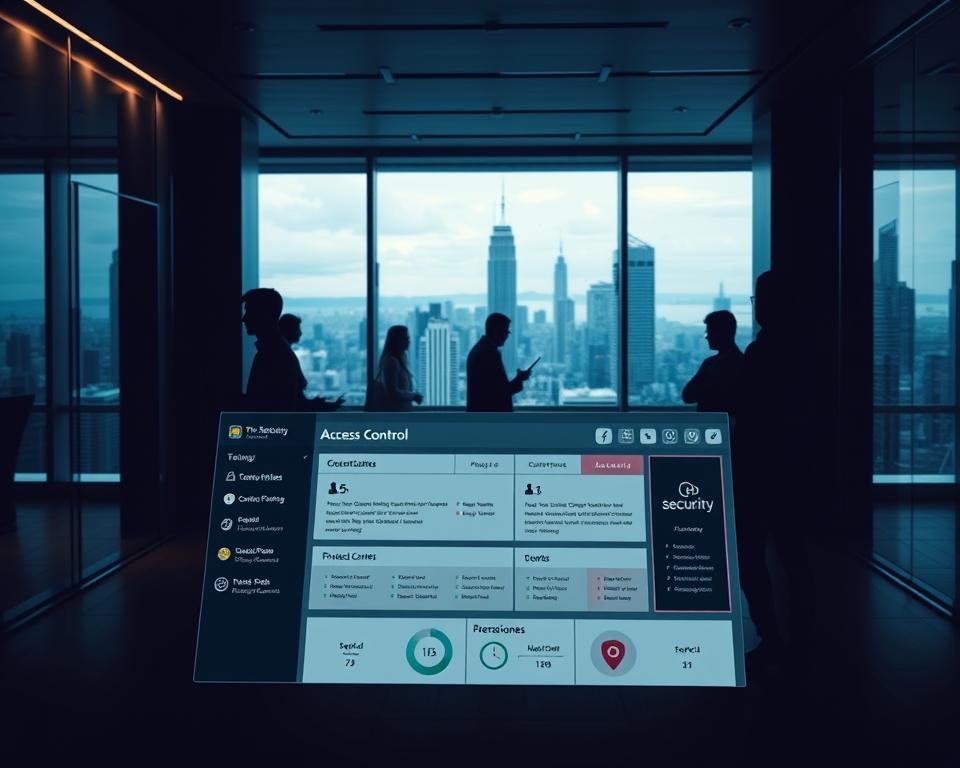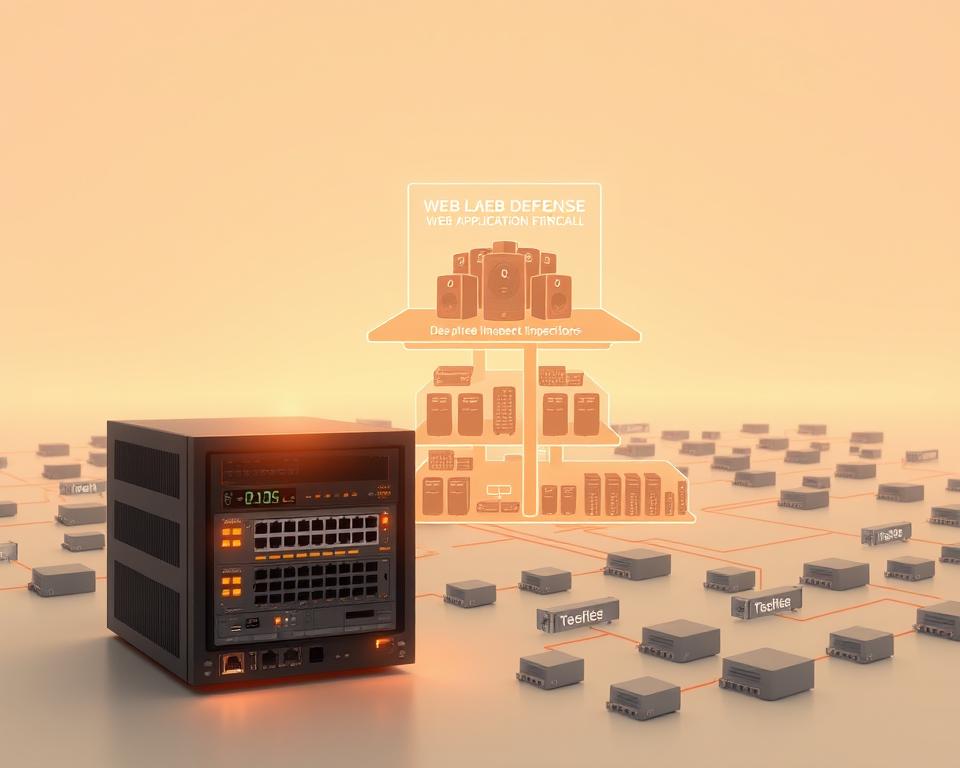In today’s digital world, web application security is key. Cyber attackers keep changing their ways. So, it’s important to stay one step ahead.
A cyber attack can cause big problems. It can lead to lost user data and harm your business’s image. So, strong security is a must for your web app.
Cyber threats are getting smarter. Knowing the latest threats is crucial to keep your web app safe.
Table of Contents
Key Takeaways
- Understanding the importance of web application security
- Recognizing the evolving nature of cyber threats
- Implementing robust security measures to protect user data
- Safeguarding your business’s reputation
- Staying ahead of potential cyber threats
Understanding the Modern Cyber Threat Landscape
It’s key to know the modern cyber threat landscape for web app security. The world of cyber threats keeps changing. This means we must always be ready for new risks.
Common Attack Vectors Targeting Web Applications
Web apps face many attack vectors. Attackers look for weak spots in code, settings, or how users interact. They often target injection flaws, cross-site scripting (XSS), and bad login systems.
OWASP Top10 Vulnerabilities
The OWASP Top10 shows the biggest web app security risks. These include bad access control, crypto failures, and security setup mistakes. Knowing these helps protect against common attacks.
Emerging Threat Patterns
New threats pop up as tech advances. For example, APIs and microservices bring new risks. Keeping up with these new threats is vital for strong security.
The Rising Costs of Security Breaches
Security breaches can cost a lot. They can hurt a company’s reputation, lose customer trust, and face legal penalties. It’s important to invest in good security to avoid these problems.
As cyber threats grow, staying alert and active in security is crucial. By understanding today’s threats, companies can protect their web apps and data better.
Assessing Your Web Application’s Security Posture
Checking your web application’s security is key to keeping it safe from cyber threats. This step involves a detailed look at your application’s defenses. It helps find vulnerabilities and weaknesses.
Conducting a Comprehensive Security Audit
A thorough security audit is vital to grasp your web application’s security level. This audit uses different methods.
Automated vs. Manual Assessment Techniques
Automated tools quickly scan for vulnerabilities. Manual assessments, however, dive deeper. They find complex issues that automated tools might overlook.
Documentation and Reporting
Good documentation and reporting are key for tracking and fixing issues. They help ensure vulnerabilities are tackled. This boosts your application’s security.
Identifying Critical Assets and Vulnerabilities
Spotting critical assets and vulnerabilities is crucial. It helps focus security efforts. Knowing what to protect helps use resources wisely.
This effort strengthens security and meets regulatory needs. Regular checks keep your security strong over time.
Implementing Robust Authentication Mechanisms
Robust authentication is key to web application security. It’s vital to make sure only authorized users can access sensitive data. This section explores how to set up strong authentication.
Multi-Factor Authentication Best Practices
Multi-factor authentication (MFA) boosts security. It asks for two or more verification steps, lowering the risk of unauthorized access. Here are some best practices:
- Combine something you know (password), something you have (token), and something you are (biometric data).
- Use adaptive MFA that changes based on risk factors like location and device.
- Keep updating MFA methods to fight new threats.
Password Policies and Management
Good password policies stop unauthorized access. This includes:
Password Hashing and Salting
Securely store passwords with hashing and salting to prevent breaches.
Account Lockout Mechanisms
Use account lockout policies to stop brute-force attacks.
Password management is more than just secure storage. It’s also about teaching users to make strong, unique passwords. And to update them regularly.
OAuth and SSO Implementation
OAuth and Single Sign-On (SSO) improve security and user experience. OAuth lets users give third-party apps limited access without sharing their login details. SSO lets users log into many apps with just one set of login details, making it easier to manage multiple accounts.
| Feature | OAuth | SSO |
|---|---|---|
| Purpose | Authorization | Authentication |
| Primary Benefit | Secure access to resources without sharing credentials | Simplified user access to multiple applications |
| Security Features | Tokens, scopes, and consent screens | Centralized authentication, MFA integration |
By using these strong authentication methods, web apps can greatly improve their security. They can protect against unauthorized access and data breaches.
Securing Authorization and Access Control
To stop data breaches and cyber attacks, strong authorization and access control are key. Authorization checks if a user can access a resource or do a certain action in a web app.
Role-Based Access Control (RBAC)
Role-Based Access Control (RBAC) is a common way to manage user permissions. It assigns users to roles based on their job duties in a company.
Designing Effective Role Hierarchies
Creating good role hierarchies is vital for RBAC. This means setting up a role structure that matches the company’s needs.
- Find the different roles in the company.
- Set what each role can do.
- Make a clear role hierarchy to ensure the right permissions flow down.
Permission Management Systems
A permission management system is key for access control. It lets admins give, take away, or change permissions when needed.
- Get a central permission management system.
- Keep checking and updating permissions to match current needs.
Principle of Least Privilege
The Principle of Least Privilege says users should only get the access they need to do their jobs. This lowers the risk of unauthorized access to sensitive data.
To follow the Principle of Least Privilege, do:
- Do regular access checks to make sure users only have needed permissions.
- Use high-privilege accounts less.
- Watch user activity to catch and handle security issues.
How to Secure Your Web App Against Cyber Threats Through Data Protection
Protecting your web app’s data is key to keeping it safe from cyber threats. With cyber attacks getting smarter, it’s more important than ever to secure your app’s data.
Encryption in Transit and at Rest
Encrypting data in transit and at rest is a must. This makes sure data stays safe, even if it’s caught by unauthorized users.
TLS Configuration Best Practices
Transport Layer Security (TLS) is vital for keeping data safe while it’s moving. Use the newest TLS versions, set up cipher suites right, and manage certificates well.
Database Encryption Strategies
Encrypting data stored in databases is also crucial. Use methods like transparent data encryption (TDE) or encrypt specific columns with sensitive info.
Secure Data Storage Practices
Keeping user data safe and following rules is essential. It helps protect sensitive info and keeps your app compliant.
Handling Sensitive User Information
Dealing with sensitive user data needs careful planning. Use role-based access control (RBAC) and encrypt all sensitive data.
Data Retention and Deletion Policies
Having clear data storage and deletion rules is important. Decide how long to keep data and when to delete it. Make sure these rules are followed by everyone.
By using these data protection steps, you can make your web app much safer. This helps fight off cyber threats and keeps users’ trust.
Preventing Injection Attacks
Stopping injection attacks is key to keeping web apps safe from data breaches and cyber threats. These attacks, like SQL injection, XSS, and CSRF, can harm a web app’s security and data.
SQL Injection Countermeasures
SQL injection happens when bad SQL code is injected into a web app’s database. To stop these attacks, several steps can be taken.
Parameterized Queries
Parameterized queries are a strong defense against SQL injection. They make sure user input is treated as data, not code. Instead of mixing user input into SQL queries, apps use placeholders for it.
ORM Security Features
Object-Relational Mapping (ORM) tools have security features to fight SQL injection. By using ORM’s query methods, developers can avoid raw SQL queries that are easy to hack.
XSS and CSRF Prevention
XSS and CSRF are other injection attacks that target web apps. XSS injects bad scripts into web pages, while CSRF tricks users into doing things they didn’t mean to.
Content Security Policy Implementation
A Content Security Policy (CSP) helps block XSS attacks. It sets rules for what content can run on a web page. CSP makes it clear what sources are okay for scripts and styles.
Anti-CSRF Tokens
To stop CSRF attacks, anti-CSRF tokens are used. These tokens are made by the server and added to forms. When a form is sent, the token checks if the request is real or fake.
| Attack Type | Prevention Technique | Description |
|---|---|---|
| SQL Injection | Parameterized Queries | Treating user input as data, not executable code |
| XSS | Content Security Policy (CSP) | Defining allowed sources for content execution |
| CSRF | Anti-CSRF Tokens | Verifying request legitimacy using tokens |
Implementing Secure Coding Practices
Secure coding is key to protecting web apps from cyber threats. It’s not just a good idea, it’s a must. By making security a part of every step in development, developers can lower the chance of security problems.
Secure Development Lifecycle
Using a secure development lifecycle (SDLC) is crucial for web app security. It means adding security steps to every part of development, from planning to launch. This way, developers can spot and fix security issues early, avoiding big problems later.
Code Review and Static Analysis
Code review and static analysis are vital for secure coding. Code reviews are when people check the code for security flaws. Static analysis tools automatically look for these issues. Doing regular code reviews and static analysis helps find security problems early.
Automated Security Scanning Tools
Automated security tools make code review better by finding security issues humans might miss. These tools can be part of the development process, giving feedback on code security all the time.
Manual Code Review Techniques
Even with tools, manual code reviews are important. They catch complex security issues tools might not see. Experienced developers can check the code for security, find vulnerabilities, and make sure it’s safe and easy to maintain.
Dependency Management
Managing dependencies is also key to secure coding. Many apps use third-party libraries, which can be risky if not managed well. Keeping dependencies up-to-date is crucial to avoid security risks.
Vulnerability Scanning for Dependencies
Vulnerability scanning for dependencies finds security issues in third-party libraries. Tools for this help developers update or patch vulnerable libraries before they become a problem.
Update and Patch Management
Good update and patch management keep web apps secure. It means regularly checking and updating dependencies to fix security issues. Keeping up with the latest patches helps avoid security breaches.
Hardening Your Web Server Configuration
Hardening your web server is key for strong security. A secure web server is the base for your web app’s safety.
Server Hardening Checklist
A detailed server hardening checklist is vital. It focuses on disabling unused services and managing file permissions.
Disabling Unnecessary Services
Turning off unused services lessens your server’s attack surface. Identify and disable services not needed to lower breach risk.
File Permission Management
Managing file permissions is crucial to block unauthorized access. Make sure files and directories have the right permissions to keep your server safe.
HTTPS Implementation and Certificate Management
HTTPS and certificate management are key to web server hardening. HTTPS encrypts data between the server and clients.
Let’s Encrypt and Automated Certificate Renewal
Let’s Encrypt offers free SSL/TLS certificates for easy renewal. Automated renewal keeps HTTPS connections secure without interruption.
HSTS and Certificate Pinning
HTTP Strict Transport Security (HSTS) and certificate pinning boost HTTPS security. HSTS forces HTTPS, and pinning accepts only specific certificates for added security.
Deploying Web Application Firewalls
Cyber attacks are getting smarter, making web application firewalls (WAFs) key for security. A WAF protects your web app from the internet, stopping bad traffic before it reaches your site.
WAF Configuration Best Practices
Setting up a WAF right is vital for its success. It means creating rules to catch and block bad traffic while letting good traffic through. Proper configuration helps your WAF stop attacks like SQL injection and XSS.
Rule-Based vs. AI-Powered WAFs
WAFs come in two main types: rule-based and AI-powered. Rule-based WAFs use set rules to spot threats. AI-powered WAFs use learning to find unusual traffic patterns. AI-powered WAFs can catch new threats better, but they need lots of data to work well.
Cloud vs. On-Premise Solutions
WAFs can be in the cloud or on your own servers. Cloud WAFs grow with your needs and are easy to start. On-premise WAFs give you more control but need your own setup.
Monitoring and Tuning Your WAF
Setting up a WAF is just the start. It needs ongoing monitoring and tuning to stay effective. Checking WAF logs and updating rules regularly helps fight new threats.
Good WAF monitoring means watching traffic, spotting false alarms, and tweaking settings. This keeps your web app safe and secure.
Continuous Security Testing Strategies
To stay ahead of cyber threats, adopting continuous security testing is key. This approach helps find and fix security weaknesses in web apps before they can be used against us.
Penetration Testing Methodologies
Penetration testing, or pen testing, is a simulated cyber attack on a web app to check its security. There are many ways to do this.
Black Box vs. White Box Testing
Black box testing tests a web app without knowing how it works, like an outside attack. On the other hand, white box testing knows the app’s inner workings, allowing for a deeper check.
Scheduling Regular Security Assessments
Regular security checks are vital for a web app’s safety. It’s smart to set these up often, based on the app’s risk level and how often it’s updated.
Automated Security Scanning Tools
Automated security scanning tools are key for ongoing security checks. They quickly spot vulnerabilities.
DAST vs. SAST Tools
DAST (Dynamic Application Security Testing) tools attack a running web app to test it. SAST (Static Application Security Testing) tools check the app’s code for flaws without running it. Both are important and work well together.
Integrating Security Testing into CI/CD
Adding security testing to the CI/CD pipeline helps find and fix issues early. This makes the app safer from the start.
By using continuous security testing, including various testing methods and tools, companies can make their web apps much safer.
| Testing Method | Description | Benefits |
|---|---|---|
| Black Box Testing | Testing without knowledge of internal workings | Simulates external attacks |
| White Box Testing | Testing with full knowledge of internal structure | Thorough examination of code |
| DAST | Dynamic testing of running application | Identifies runtime vulnerabilities |
| SAST | Static analysis of source code | Identifies vulnerabilities early |
“Continuous security testing is not a one-time task but an ongoing process that requires regular assessments and the use of various testing methodologies and tools.”
Implementing Effective Logging and Monitoring
Keeping web applications safe and sound requires good logging and monitoring. These practices help spot security threats early and respond quickly to any issues.
Security Information and Event Management (SIEM)
SIEM systems are key for managing log data from different parts of an IT system. They offer real-time monitoring and alerts, helping security teams catch threats fast.
Log Collection and Aggregation
Getting logs from various sources and putting them together is vital for SIEM. This means collecting logs from servers, network devices, and apps, and storing them in one place for analysis.
Setting Up Meaningful Alerts
It’s important to set up alerts in SIEM systems that actually mean something. This way, security teams get notified of real threats without getting bogged down by false alarms. Alerts should match the specific security needs of the organization.
Anomaly Detection and Alerting
Anomaly detection is a big part of logging and monitoring. It helps find unusual activity that might be a security risk. By knowing what normal activity looks like, systems can alert on anything that’s not normal.
Baseline Establishment
Creating a baseline means watching and analyzing normal activity over time. This helps understand what’s usual. Then, anything that’s not usual can be seen as an anomaly.
Response Automation
Response automation lets the system act on its own when it spots certain anomalies. This could mean blocking suspicious IP addresses or isolating systems that are acting strangely.
Using SIEM and anomaly detection well can really help organizations spot and handle security issues better.
Creating an Incident Response Plan
Cyber threats are on the rise, making a solid incident response plan essential. It helps organizations quickly and effectively handle security incidents. This way, they can reduce the damage caused.
Breach Detection Procedures
Breach detection is key in an incident response plan. It means spotting signs of a breach and acting fast to stop it.
Identifying Indicators of Compromise
Indicators of Compromise (IoCs) show if a breach has happened or is happening. Look out for odd network activity, system changes, or data transfers without explanation. Monitoring for IoCs is vital for catching breaches early.
Initial Response Steps
When a breach is spotted, quick action is needed. This includes isolating systems, telling important people, and calling the incident response team. Acting fast helps stop more harm.
Containment and Recovery Strategies
After spotting a breach, it’s important to contain and recover. This means figuring out the damage and doing a post-incident analysis.
Damage Assessment Techniques
Damage assessment looks at how bad the breach is. It checks for data loss, system downtime, and financial hits. Doing a detailed assessment helps plan recovery.
Post-Incident Analysis
A post-incident analysis finds out what caused the breach and how well the response was. It’s key for making the incident response plan better and improving security.
The table below shows important parts of an incident response plan and what they do:
| Component | Description |
|---|---|
| Breach Detection | Spotting signs of a breach and acting quickly to stop it. |
| Containment | Keeping affected systems separate to prevent more damage. |
| Recovery | Getting systems and data back to normal. |
| Post-Incident Analysis | Looking into the breach to find causes and improve. |
Staying Compliant with Security Regulations
It’s vital to follow security rules in today’s world. Data breaches are common, and laws are getting stricter. This is to protect our data and privacy.
Companies dealing with personal data face many rules. These include the GDPR and CCPA. Following these rules helps build trust and keeps data safe.
GDPR, CCPA, and Other Regulatory Requirements
The GDPR and CCPA are big deals for businesses worldwide. The GDPR is for the EU and sets high data protection standards. The CCPA, in California, USA, gives people more control over their data.
Data Subject Rights Implementation
It’s key to follow GDPR and CCPA rules on data subject rights. This means:
- Being clear about how data is used
- Letting people see their data
- Handling requests to delete data
- Allowing data to be moved
Documentation and Reporting Requirements
Keeping good records and reporting incidents is crucial. Companies must:
- Record how data is processed
- Do Data Protection Impact Assessments (DPIAs) when needed
- Tell authorities about data breaches quickly
Security Compliance Automation
Using tech to automate security compliance makes things easier. It helps avoid mistakes and saves time.
Compliance Monitoring Tools
Compliance tools help keep an eye on how well you’re doing. They spot problems early.
Audit Preparation Strategies
Being ready for audits is important. Good strategies include:
- Keeping policies up to date
- Doing internal checks
- Having accurate and easy-to-find documents
Here’s a table showing some key differences between GDPR and CCPA:
| Regulation | Geographic Scope | Data Subject Rights | Penalties for Non-Compliance |
|---|---|---|---|
| GDPR | EU and EEA | Access, Erasure, Portability, etc. | Up to €20 million or 4% global turnover |
| CCPA | California, USA | Access, Deletion, Opt-out of sale | Up to $7,500 per intentional violation |
Conclusion
Keeping your web application safe from cyber threats is a constant task. You need to stay alert and proactive. This way, you can protect your web application and its users.
Good web application security means using many different methods. You should check your security, use strong login systems, and follow security rules. These steps help lower the chance of a security breach and keep your users’ data safe.
Cyber threats are always changing, so you must keep up with new security methods. By focusing on web application security, you can keep your application safe. This builds trust with your users.



















